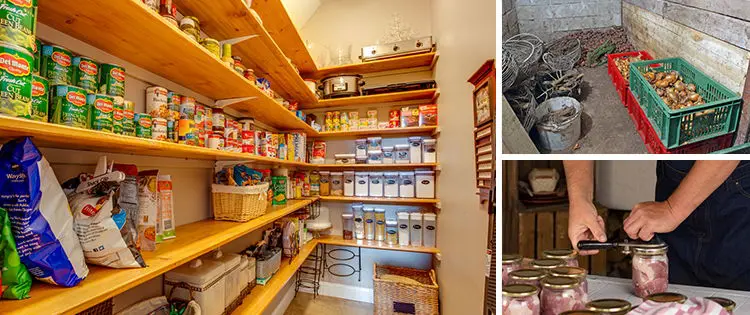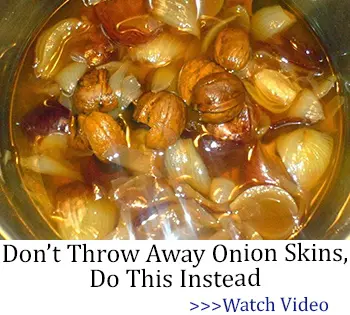A Great Depression pantry provides everything I need to make complete and nutritious meals.
To do this, I need to store a variety of food in the most economical way possible – so this plan focuses on ingredients instead of complete meals. I also need to gain the skills to store and cook with these basic supplies. It’s a wonderful method to build food storage. I have four keys to make a Great Depression pantry.
1. Get Back To Basics
Basics are the way to go for a Great Depression pantry. Instead of planning complicated meals, I store supplies for simple meals. Stews, chili, and soup are fantastic for combining your stored ingredients. Casseroles with pasta, rice, or potatoes are also options for complete meals to feed an entire family.
2. Economical
Building a Great Depression pantry is budget-friendly! Basic ingredients cost much less than pre-made meals and have a longer shelf life. By saving money, I stored more food that is flexible to make a variety of meals. You’ll see how an economic pantry can still be nutritious and tasty when you make your own. If you have a garden, it’s economical to bottle and dry your own fruits and vegetables.
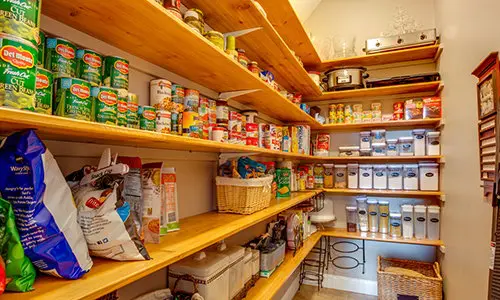
3. Learn How To Do It Yourself
When starting to build a Great Depression pantry, I realized I needed new skills.
Baking bread, gardening, and bottling (also called canning) my own food was just the beginning.
I also found growing and preparing food is rewarding. Along the way to building my pantry, I discovered a secret to having fresh vegetables even in the middle of winter! Stored seeds and grains produce sprouts in a few days and are so inexpensive. Sprouts are packed with nutrients like Vitamin K, phosphorus, magnesium, and more!
This is a must-do on my learning list.
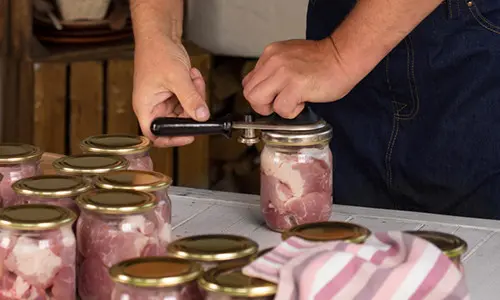
4. Planning
Finally, to build a Great Depression pantry, I needed to know exactly what I needed and lists!
So, here are my reasons for storing certain types of food and what I put in storage.
Grains are essential to store in a Great Depression pantry. Wheat bought and stored in large plastic bins lasts for over thirty years! To use it, you’ll need a wheat grinder to turn your wheat into flour. You can also cook roughly ground wheat like oatmeal for cereal – it has a wonderful flavor and can be sweetened with sugar or honey.
Flour also thickens soup or sauces and can be used to make tortillas, bread, and biscuits. You can even make pasta!
But there are more grains to store than wheat. By keeping a variety, I can make more meals. Rice, quinoa, and millet are basic side dishes but can also be used in soups and other meals. Oats, rye, buckwheat, and flax can be added to bread or cereal. Ground corn can also make tortillas or cornbread. Grains are called the staple of life for a reason!
They can be made into so many dishes.
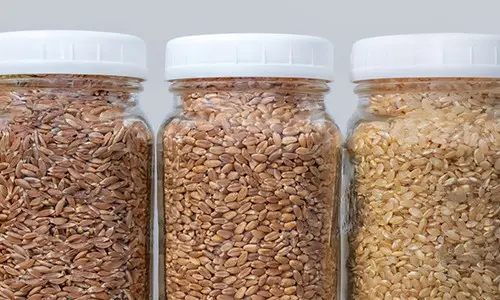
Grains that are great for storage:
• Wheat • Rice • Oats • Rye • Corn • Quinoa • Buckwheat • Millet • Flax
Protein is needed for our health, but meat is expensive and eggs and most dairy don’t store well for long periods of time. Nuts are also expensive and have a short shelf life. I store dried beans. Even though beans taste best if used in a couple of years, they last longer and can still be used when stored in an airtight container. (Soybeans are an exception to this rule and need to be used more quickly, but they’re high in protein.) The trick to using dried beans is to soak them in salted water for 4-12 hours. But longer is usually better. Beans are great in soups, stews, salads, or as a side dish. I’ve even pressed them together with a little oil and spices to make patties that I cooked on the grill like a hamburger.
Related: 11 Food Storage Myths
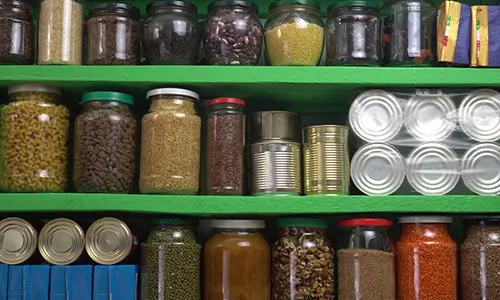
Beans and Lentils to add to the pantry:
• Great Northern • Pinto • Black-Eyed Peas • Navy • Chickpeas • Kidney • Green Peas • Soybeans • Lentils (they are available in different colors) • Peanuts (this is actually a legume)
Vegetables and fruits are essential for good nutrition. But these are hard to store if you don’t have a garden. In my garden, I grow green beans, peas, cucumbers, beets, carrots, potatoes, sweet potatoes, peppers, tomatoes, radishes, eggplant, onions, and zucchini. For fruits, I have strawberries, an apple tree, a peach tree, and a pear tree. Those are the basics that I bottle to keep in my pantry. But if you don’t have a large garden, there are more options. You can make a cold frame box or even a small garden in a cardboard box!
Using your oven as a food drier is another option. All you need to do is set the oven to the lowest temperature, slice your fruit and veggies to about ¼ inch (or about ½ a cm), and bake for about 6-8 hours or until the moisture is gone.
A cellar is another way to store food like potatoes or other root vegetables and apples to eat through the winter. It must be dry and cool for this to work. Since I don’t have a cellar, I needed another way to store vegetables that didn’t involve bottling. This is when I learned about sprouts. They store well for about five years. They’re cheap! And they’re so, so delicious!
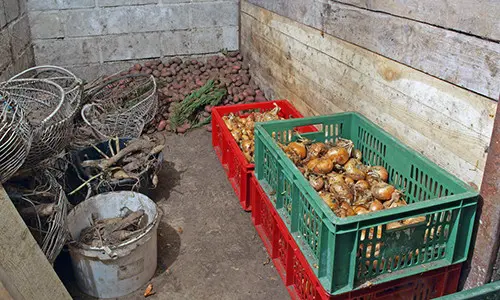
Sprouting Supplies:
• Bottles • Cheesecloth • Wheat • Mung Beans • Lentils • Peas • Sunflower Seeds • Soybeans • Pinto Beans • Mustard Seeds • Broccoli Seeds • Radish Seeds • Chia Seeds
In addition to all these basics, I keep other miscellaneous supplies in my Great Depression pantry. These items include leavening agents, spices, and sweeteners. Most of the herbs I grow myself. Sugar and honey lasts indefinitely when stored properly but are more expensive than the most basic items. Because of their shelf life, I felt like it was worth saving to include them. Cereal made from whole grains tastes so much better with something sweet added. I also learned how to bottle butter. It only lasts a couple of years but is easy to rotate.
Additions:
• Baking Soda • Baking Powder • Salt • Pepper • Dried Basil • Dried Oregano • Dried Cilantro • Dried Parsley • Dried Rosemary • Dried Sage • Cinnamon (This is one I splurge on and buy in bulk from an Indian grocery store) • Sugar • Honey • Bottled Butter
Now that you see how easy it is to build a Great Depression pantry, I hope you make your own.
It’s fun to find new recipes to make from scratch. And it is surprising how much better meals taste when they’re made from basic ingredients.
Like any home storage plan, you can take it in small steps to keep it budget-friendly.
Building a Great Depression pantry is the most economical way to store food.
You may also like:
How to Build a Native American Subterranean Roundhouse in Your Backyard (Video)
How To Build An Outdoor Mud Oven
Canning Secrets Nobody Tells You About

